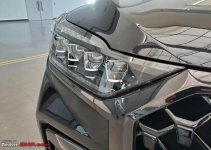Toyota's contemporary Body on frame SUV's will find it tough in India from pricing perspective. 4Runner with 4.0 V6 and Sequoia with 5.7L v8 will not find the market as the hilux based Fortuner does. Exactly opposite reason toyota doesn't pitch hilux/fortuner in the US.I don’t know why they charge such premium for outdated design and technology in India. They do have very good lineup in European and US market but for some unknown reasons they want to sell us craps like Etios and Liva at the cost of cars of one or two segments above.
Just compare the Fortuner with Endavour and see which one is VFM product (in India)
Indian Automotive Sector
- Thread starter Amal
- Start date
You are using an out of date browser. It may not display this or other websites correctly.
You should upgrade or use an alternative browser.
You should upgrade or use an alternative browser.
Thera is a large untapped market of lower powered ADV/Dual sports and Sports Tourer in North America and Europe. People don’t want to put their costly V Storms and Africa Twins on difficult trails due to the fear of breakdowns and very costly repairs.I know what you are saying.
I was not a fan of the RE 350 bullet and till mid 2000's I think they did a shoddy job. But then post 07, their transformation was remarkable.
As they stand now, I am not a fan of the Classic 500 which was discontinued but i can clearly see the charm in it, I am ambivalent about the Himalayan, and I thought they could have done a better job with the counterbalanced single cylinder. RE twins excite me, especially the GT650, I test drove it and liked it with better cams and flywheels, and a full classic fairing and half fairing I think it can create a niche of it's own. It has the potential to do what T120's and R9T's do for the Triumph and BMW.
View attachment 17896
View attachment 17897
BMR r9T
View attachment 17898
Triumph Thruxton
View attachment 17899
One thing RE has to do which is unique compared to other mfg's is continue to be a segment leader in India and expand it's global products, a challenge unique to it. On that front it seems to be doing well too.
Himalayan, although isn't as impressive to me in the US, it becomes a very potent ADV option in India; with new launches prepared in Meteor 350, new thunderbird, 650 Cruiser based on the Twin650, a possible 650 tracker/himalayan option, and 350 Sherpa. RE is upping it's game quite a bit.
At this stage for RE, I am not that keen on seeing models from it, but engine platforms. 650 Twin has the making of a good platform, It has another 10-12 HP in it imo. 350 and 250 mills in India should if are properly counterbalanced and have isolators, then they will form a solid engine. If RE can develop a one KTM like Vtwin and cross-plane triple, then things would get really interesting real fast. A vtwin on a Norton Commander like platform, and an 800- 900 triple in a fully new series of a Naked, ADV, faired supersport (~Speed Triple) and a sport-tourer (Similar to yamaha offering : Tenere, Tracer, MT09, SCR 900). Once some of the solid engine platforms for the next decade are established, RE would be a force to reckon with.
500 Classic needs to be replaced, There is something about it's classic design that I don't think other "modern classic " can match. But it needs a good chassis, and good engine that doesn't keep your head vibrating an hour after the ride. If they stick the 650twin in a classic version, it will easily outsell the interceptor.
View attachment 17900
At present RE needs to focus on sub 1000 cc bikes that are affordable,reliable have modern engine and equipments and most importantly belongs to RE heritage ie Classic appeal. IMO 650 is a sweet spot of this category and they need to build on their current 650 which imo is very sound platform for future development.
Last edited:
Yes, there is, and thus the wide acceptance of the Himalayan despite it's shortcomings, Put a motor like a cb500x 500 twin, use the same motor for the new 500 classic and it will dominate the small displacement adv segment. Dual sport on the other hand is different game, anyone who wants to get a serious Dual sport is not looking at himalayan; if you are looking to compete with the crf450l, KTM Enduro and the DRZ400, you will need a new bike. With a more powerful engine, Himalayan can definitely appeal to trail biased ADV, but not a dual sport.Thera is a large untapped market of lower powered ADV/Dual sports and Sports Tourer in North America and Europe. People don’t want to put their costly V Storms and Africa Twins on difficult trails due to the fear of breakdowns and very costly repairs.
At present RE needs to focus on sub 1000 cc bikes that are affordable,reliable have modern engine and equipments and most importantly belongs to RE heritage ie Classic appeal. IMO 650 is a sweet spot of this category and they need to build on their current 650 which imo is very sound platform for future development.
They can try designing a dual sport too provided they have a good engine capable to compete with that of CRF450.Yes, there is, and thus the wide acceptance of the Himalayan despite it's shortcomings, Put a motor like a cb500x 500 twin, use the same motor for the new 500 classic and it will dominate the small displacement adv segment. Dual sport on the other hand is different game, anyone who wants to get a serious Dual sport is not looking at himalayan; if you are looking to compete with the crf450l, KTM Enduro and the DRZ400, you will need a new bike. With a more powerful engine, Himalayan can definitely appeal to trail biased ADV, but not a dual sport.
To me it seems the most important part of a good bike is its engine.
I'm sorry. I didn't notice your response. Actually this just turned up on my YT feed for some unknown reason. Last I checked there were some 25 videos on the Roxor made by American vloggers & all this for an off roader.I have been following roxor on youtube. It's a fun machine.
At this point I am quite curious to see how Royal Enfield progresses in the US and Euro markets.
On a different note M&M seems to have lost their case against Chrysler for usage of the term Jeep & it's general design for the US market ( only?).
Off roading is a big thing here. People go crazy over these things here.I'm sorry. I didn't notice your response. Actually this just turned up on my YT feed for some unknown reason. Last I checked there were some 25 videos on the Roxor made by American vloggers & all this for an off roader.
On a different note M&M seems to have lost their case against Chrysler for usage of the term Jeep & it's general design for the US market ( only?).
The Transport Ministry has eased the applicability date for implementing next stage of emission norms for tractors (TREM Stage-IV) from Oct this year to 1st Oct next year. Acting upon the request from Ministry of Agriculture, Tractor Manufacturers & Agriculture Associations, For the Construction Equipment Vehicles, the applicability of next phase of emission norms are proposed to be applicable wef 1st Apr 2021, providing a deferment of six months.
Royal Enfield KX650 Cruiser Spied Sans Camouflage
The cruiser will be powered by the same 650cc engine that the current 650 twins have.
by Praveen Kumar
14 October, 2020

Looks like Royal Enfield has no intentions of slowing down
Development mules of the upcoming Royal Enfield KX650 cruiser have been spied undisguised while they were undergoing testing on our roads.
We term it as the KX650 since it takes some styling cues from the Concept KX that the bikemaker showcased at the 2018 EICMA show. Design-wise, the middleweight cruiser is pleasing to look at and at the same time, it does not possess any standout styling element.
It gets a circular headlight, round indicators and mirrors, wide handlebar, teardrop petrol tank, black engine casing, split seats, wider rear fender, twin exhaust pipes and a circular tail light. This new cruiser will also come with USD forks upfront (a first for an Enfield product), twin shocks at the back, staggered alloy wheel setup and a single disc each at the front and at the rear. To put it simply, the bike has classic design with modern mechanicals. Features such as an assist and slipper clutch, a digital and analogue setup cluster and dual-channel ABS are expected to be offered on the KX650.
Powering the Royal Enfield KX650 spied motorcycle is the 648cc parallel twin that also powers the current 650 twins. The motor makes 47 HP and 52 Nm and comes mated to a 6-speed transmission in the 650cc models on sale and the same is expected on the new cruiser.
Launch of the KX650 is expected to take place next year after the launch of the new generation Classic 350. So, the timing would be by the second half of 2021. Expect the motorcycle to be priced under Rs. 3.50 lakhs (ex-showroom) and take the fight to the much pricier Kawasaki Vulcan S.
Royal Enfield KX650 Cruiser Spied
- Royal Enfield’s upcoming 650cc cruiser spied undisguised
- Bike gets classic design with modern mechanicals
- Expected to be launched by next year after the new Classic 350

The bike was spotted while on test runs back in August this year

Royal Enfield KX650 Cruiser Spied Sans Camouflage
Royal Enfield KX650 Cruiser Spied Sans Camouflage. The Upcoming Bike Is Expected To Be Launched After The Next Gen Classic 350 Is Introduced
 www.motorbeam.com
www.motorbeam.com
Sweet. So its the cruiser they were talking about. The engine looks similar to Himalayan.Royal Enfield KX650 Cruiser Spied Sans Camouflage
The cruiser will be powered by the same 650cc engine that the current 650 twins have.
by Praveen Kumar
14 October, 2020
View attachment 18266
Looks like Royal Enfield has no intentions of slowing down
Development mules of the upcoming Royal Enfield KX650 cruiser have been spied undisguised while they were undergoing testing on our roads.
We term it as the KX650 since it takes some styling cues from the Concept KX that the bikemaker showcased at the 2018 EICMA show. Design-wise, the middleweight cruiser is pleasing to look at and at the same time, it does not possess any standout styling element.
It gets a circular headlight, round indicators and mirrors, wide handlebar, teardrop petrol tank, black engine casing, split seats, wider rear fender, twin exhaust pipes and a circular tail light. This new cruiser will also come with USD forks upfront (a first for an Enfield product), twin shocks at the back, staggered alloy wheel setup and a single disc each at the front and at the rear. To put it simply, the bike has classic design with modern mechanicals. Features such as an assist and slipper clutch, a digital and analogue setup cluster and dual-channel ABS are expected to be offered on the KX650.
Powering the Royal Enfield KX650 spied motorcycle is the 648cc parallel twin that also powers the current 650 twins. The motor makes 47 HP and 52 Nm and comes mated to a 6-speed transmission in the 650cc models on sale and the same is expected on the new cruiser.
Launch of the KX650 is expected to take place next year after the launch of the new generation Classic 350. So, the timing would be by the second half of 2021. Expect the motorcycle to be priced under Rs. 3.50 lakhs (ex-showroom) and take the fight to the much pricier Kawasaki Vulcan S.
Royal Enfield KX650 Cruiser Spied
View attachment 18267
- Royal Enfield’s upcoming 650cc cruiser spied undisguised
- Bike gets classic design with modern mechanicals
- Expected to be launched by next year after the new Classic 350
The bike was spotted while on test runs back in August this year

Royal Enfield KX650 Cruiser Spied Sans Camouflage
Royal Enfield KX650 Cruiser Spied Sans Camouflage. The Upcoming Bike Is Expected To Be Launched After The Next Gen Classic 350 Is Introducedwww.motorbeam.com
Sweet. So its the cruiser they were talking about. The engine looks similar to Himalayan
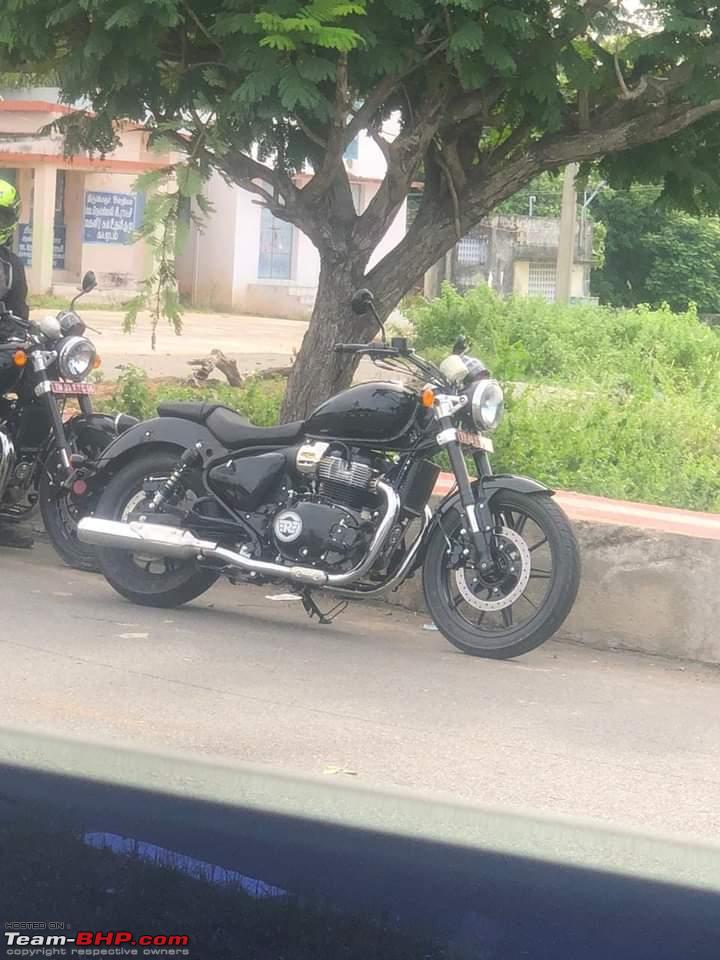
Holy smoke. Its twin

@Milspec how's that !
Last edited:
An Indian-Made Motorcycle With a Retro Look Is Coming After Harley
Royal Enfield is betting its stylish, low-cost bikes can win over young Western consumers.
PHOTO: ALAMY
By
Ari Altstedter
October 15, 2020, 1:30 AM GMT+5:30
The sun was only barely up as the group of about 40 bikers roared away from Mumbai, bound for the foothills of the Western Ghats mountain range. On the multilane overpasses leading out of India’s business capital, most of the riders formed a convoy, while others, deputized to serve as “pilots,” ranged up and down the roadway to ward off interloping motorists. By the time the group hit the vast sprawl of farm fields and light industry in the city’s hinterlands, it effectively ruled the road.
Sporting heavy biker jackets, a smattering of aviator sunglasses, a diverse array of beards, and one or two mustaches waxed rakishly upward at the ends, the Mumbai chapter of the Royal Indian Devote’s [sic] motorcycle club was out for one of its regular rides. Because this particular expedition took place on Jan. 26—Republic Day, India’s equivalent of the Fourth of July—some bikers were flying oversize national flags that flapped violently above the backs of their machines as they accelerated. Children pointed, bicyclists waved, and one man, driving his family in a small sedan, offered up a crisp salute.
The bikers’ destination? A juice company’s factory store and eatery, well known in Mumbai for its fruit punch, decadent ice cream sundaes, and cocktail liqueurs.
After briefly refreshing themselves at the restaurant and stocking up on curaçao and grenadine in the adjoining shop, they returned to the city. Few on the ride were blessed with abundant spare time—not with day jobs that included managing risk for a major bank, marketing for an organic food company, and handling IT at the Mumbai stock exchange. On the way back, a member raced ahead and dismounted to record a video for the club’s Instagram account. In classic biker style, one of the riders was wearing a T-shirt with cutoff sleeves. On the chest: the logo of the sitcom Friends.
The Devote’s differ from typical motorcycle enthusiasts in more than their watering hole and fashion preferences. For one thing, they’re young. Almost everyone in the club qualifies as a millennial, whereas the median age of a U.S. rider is 50. The second is that they exclusively ride Royal Enfield bikes. All but unknown in the U.S. and Europe, Enfields—retro rides that would look familiar to 1960s-era Steve McQueen—have become in recent years a coveted lifestyle statement among young, upwardly mobile Indians. As a result, Chennai-based Royal Enfield, which began as the subcontinental unit of a British manufacturer by the same name and kept chugging along when the parent went bankrupt, sold more than 650,000 motorcycles in India last year—a volume equivalent to the entire U.S. market.

Royal Enfield CEO Siddhartha Lal.
PHOTOGRAPHER: IAN GAVAN/GETTY IMAGES EUROPE
Royal Enfield’s success in bringing bike culture to India’s millennial and Gen Z demographics—collectively, more than half a billion young people—has started to turn heads outside the country. Sales are rising sharply in markets including Brazil and Indonesia, places where bikes have traditionally been viewed as utilitarian transport tools, not expressions of personal style. The company is now making a high-stakes bet on the U.S. and Europe, where producers such as Harley-Davidson Inc. and Indian Motorcycle have been struggling for more than a decade to expand sales as younger consumers choose other hobbies. Siddhartha Lal, the heir to the automotive conglomerate that controls Enfield, says he can win over Western enthusiasts with stylish bikes that cost far less than those made by rivals—and perhaps attract younger riders to revitalize a customer base now dominated by aging boomers.
It’s a risky strategy, one that assumes a motorcycle culture emerging from a densely populated South Asian country—where exceeding 50 mph on anything but a few freeways risks a fatal collision with a motorized rickshaw or a cow—can translate in the lands of Easy Rider and The Great Escape. And the havoc caused by the novel coronavirus could make it harder still. The global economic collapse will leave already cash-strapped young people with even less money for indulgences such as stylish motorbikes, even Indian-made ones that start at a little more than a third the price of a Harley. And though it’s hard to think of a more socially distanced outdoor activity than group rides, the Devote’s, like all other motorcycle clubs in India, have had to suspend theirs since Prime Minister Narendra Modi imposed a nationwide lockdown in late March.
Lal is pushing ahead nevertheless, anticipating that the appeal of riding will only have grown for the millions of Western consumers who spent much of the year stuck at home—especially by comparison with dining out, travel, and other popular pastimes that have proved to be vectors for infection. “I could be great in India and Brazil and Thailand and Africa,” he says. “But if I’m not in Europe and America, then I’m not a global brand.”
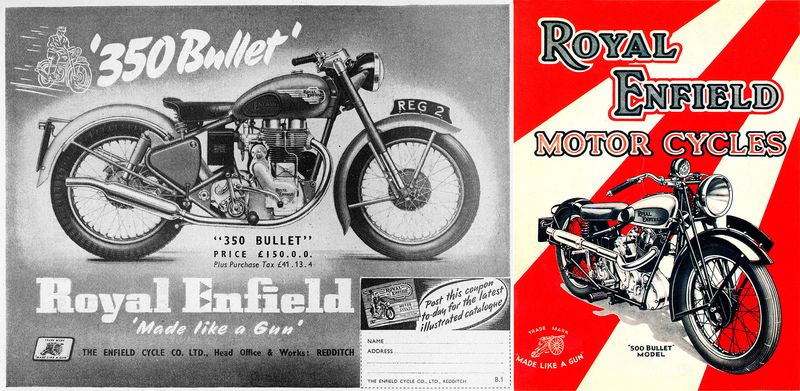
Ads from 1953 (left) and 1933.
PHOTO: ALAMY
Originally a manufacturer of bicycles in the English Midlands, Royal Enfield got its name when it was contracted to make precision parts for the Royal Small Arms Factory in Enfield, outside London, in 1893. Eight years later the company began attaching small engines to its bicycles—a pivot that got more attention from the British military, which was looking for ways to swiftly move men and messages that didn’t involve hooves. The motorcycles Enfield later developed saw service in both World Wars, with one model, the Flying Flea, light and rugged enough to be dropped with paratroopers who could then roar onto the battlefield.
India, newly independent in the years after World War II, was an obvious market for the bikes. In 1952 the nascent Indian Army ordered 500 of Enfield’s flagship Bullet model—“Made Like a Gun,” went its tagline—to patrol the country’s inhospitable borders with China and Pakistan. Three years later the British company joined with Madras Motors, in the southern city now known as Chennai, to form a local unit and factory.
The 1960s may have been the cultural heyday of classic motorcycles, but their commercial performance was a different story. Cheap, reliable Japanese models were beginning to flood the U.S. and European markets, a development that drove several old-line manufacturers out of business. One of them was Royal Enfield, which ceased operations in 1970. The Chennai arm, though, was majority-owned by locals, in line with protectionist laws that prevented foreign companies from controlling Indian manufacturers. It barely survived: Japanese bikes were taking off in India, too, and Enfields retained only a tiny niche, populated by die-hard fans who didn’t mind peculiarities such as balky engines that frequently seized up or leaked oil. By the late 1980s the company was barely profitable and loaded with debt.
Enter Vikram Lal, Siddhartha’s father. Eicher Motors Ltd., the Delhi-based truck manufacturer he controls, bought a large stake in Royal Enfield in 1990 and became its majority shareholder three years later, intending to clean up the balance sheet and revive the brand. Siddhartha was in his late teens at the time, studying economics at Delhi’s St. Stephen’s College, where he was by his own account an indifferent student. He wasn’t much more interested in sports or any particular hobbies. Mostly, the younger Lal says, he was “middling” at all of them.
Then, one day not long after Eicher bought the company, a bright-red Enfield appeared in the family garage. Lal describes his adoption of the bike as perhaps the crucial moment in the formation of his identity. Compared with the compact, fiberglass-clad Japanese models popular around town, its engine made a “deep thump” rather than a “tinny purr,” he says. He began riding it to school, becoming known around campus as the guy on the Enfield. Friends asked him to take them for rides, and he soon found a group to go on longer trips with, sometimes even up into the Himalayas.
His love for the bike, however, didn’t inspire Lal to consider a career at Royal Enfield. After graduating from St. Stephen’s he drifted between internships his father had secured—one at the German truckmaker MAN SE, another at Enfield, which even then failed to announce itself as his calling—before going to the U.K. for a degree in automotive engineering.
When Lal returned to India he began working in Eicher’s consumer maps division. He was playing around with the idea of leaving to get an MBA when, in 1999, Vikram told him that Royal Enfield had just had its worst year ever. The board was considering shutting it down. Lal thought that would be a shame. Surprising even himself, he made a suggestion to his father: Why don’t I try running it? The Eicher board said yes—Lal might have been aimless, but he was the boss’s son—with two conditions: In 12 months, Enfield would have to stop asking for cash from Eicher. And in 24, it needed to at least be breaking even. If it couldn’t clear either hurdle, the board would pull the plug.
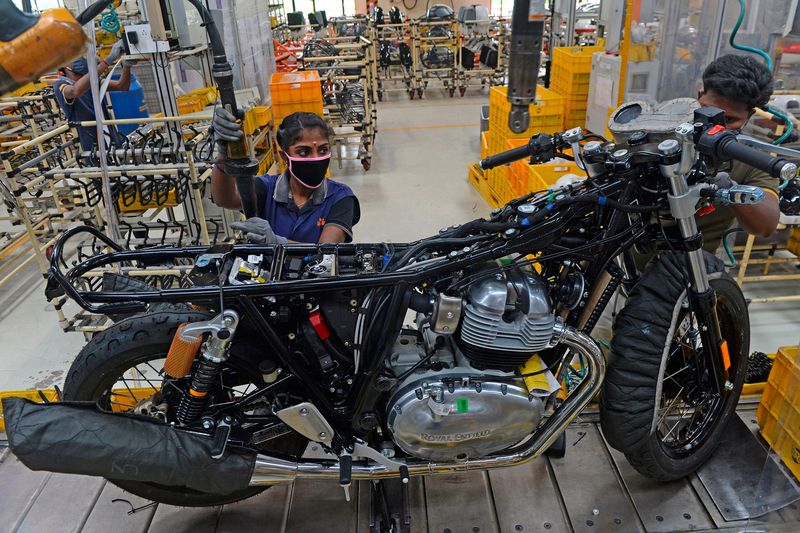
Royal Enfield’s Chennai factory.
PHOTOGRAPHER: ARUN SANKAR/GETTY IMAGES
I met Lal in February at his now-retired father’s office, which is located in an expansive brick complex, complete with an art gallery and lush private park, in one of the poshest areas of New Delhi. Although at 47 he’s closer in age to the average Harley enthusiast than the millennials who buy Enfield bikes, Lal’s look is much closer to that of his customer base. His hair is buzzed modishly close at the sides of his thick pile of curls, and his gray-flecked beard is the optimal density for brewing Brooklyn craft beer. He’s also adopted the youthful habit of privilege checking, readily conceding that he got the job running Enfield because of his dad. “All of this was entirely and only because I was the promoter’s son,” he said, using an Indian term to refer to an owner-operator. “A random bloke at 27 wouldn’t have got this job.”
During our interview, he presented the road map he followed to revive the company as simple common sense. Shortly after taking over he set out on a series of long-range rides around India, visiting dealers and chatting with customers. One of the key problems, he said, was obvious: The company had made a habit of offering its bikes at a discount, partly to increase orders at a brand-new factory it had built in western India. Rather than inducing a flood of sales, Lal discovered, the strategy had mostly made loyal customers reluctant to pay full price. So he signed a letter to every Enfield dealer instructing them to tell customers that, for the next year, there would be no discounts.
Sales dropped for the first month, but after that they started climbing, surpassing their old volumes and underpinning a turnaround that took care of more than half of Lal’s negative cash-flow problem. He then set about plugging all the holes where Enfield was losing money—at first, by spending some. He accepted huge severance costs to close the new plant so he could focus on the older operation in Chennai. There he brought in precision-machining equipment from Germany and Japan, allowing workers to address the bikes’ oil leaks by more snugly fitting together the crankcase’s two pieces, and the engine-seizing issue by tailoring pistons exactly to the cylinder block.
He also bought specially fitted trucks so the company no longer needed to secure bikes with cloth and hay before sending them off on India’s juddering highways, reducing the amount of damaged inventory arriving at dealerships. And when a dealer refused to renovate his dingy store, Lal opened one himself across town. This new strategy succeeded in curbing losses, satisfying the Eicher board’s conditions for keeping Royal Enfield alive—and so improved Lal’s standing that he became chief executive officer of the broader company in 2006. None of these changes solved the fundamental problem, though: Lal just wasn’t selling enough bikes.
Juicing sales would require new models. Lal decided to start with an overhaul of the fabled Bullet. Its basic design was little changed from the two-wheelers that had carried Indian border guards through the Himalayas in the 1950s, including a clunky cast-iron engine. Updating the motor and electronics while retaining the look and feel of the original would be a challenge, not least where sound was concerned. Modern aluminum engines, Lal was disappointed to learn, couldn’t replicate the roar he’d fallen in love with as a young man.
It took two years of design work, including a lot of noise testing, for the company’s engineers to find a compromise. By making the motor’s piston longer and thinner, they could get a deeper engine sound during acceleration, at the cost of some speed. And with a heavier flywheel, the bike would still make the throaty thunk thunk thunk that let everyone know you were on an Enfield at a red light. But the new model would also be affordable, retailing for less than $2,000 in India.
The cost of improving Enfield’s products left little cash for marketing, and in the early days Lal promoted the bikes mostly by riding them. The company began organizing trips into the Himalayas or from Mumbai to Goa for customers, hoping they would become evangelists for their new wheels. It helped that India, which escaped the worst of the global financial crisis, was booming. Per capita gross domestic product expanded fivefold from 1998 to 2018, giving millions of young consumers money to burn for the first time.
The new Bullet, plus a model called the Classic that leaned even harder into the 60s aesthetic, went on the market in 2009, catching the middle of this long financial tailwind. That year, Royal Enfield sold about 52,000 motorcycles. In 2012 it was moving more than 100,000, overwhelmingly in India, a number that had almost tripled by 2014—representing more than enough revenue to finance other upgrades to the product line. In its last financial year before the pandemic struck, the company sold about 824,000 bikes globally. Harley, by contrast, shipped about 218,000.
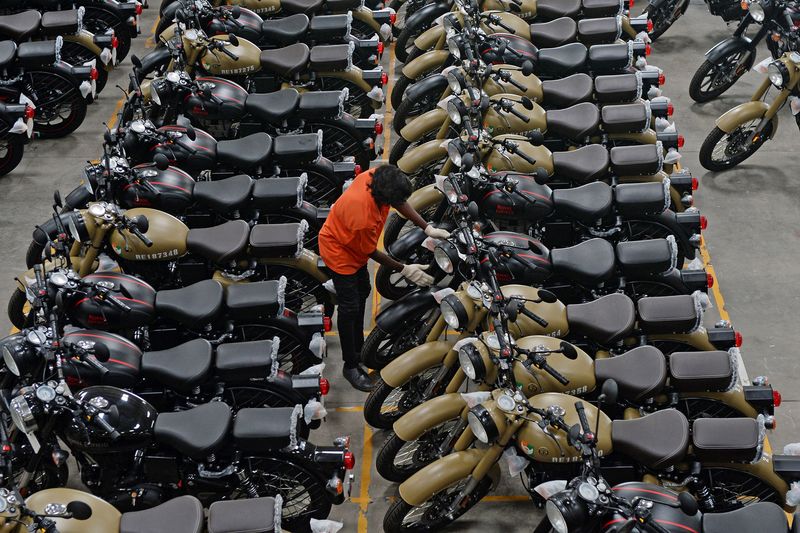
A factory worker checks a finished motorcycle.
PHOTOGRAPHER: ARUN SANKAR/GETTY IMAGES
In a room the size of an aircraft hangar, under a flood of tropical sunlight from wide apertures set in a high corrugated-steel roof, two motorcycle assembly lines emitted dissonant symphonies of clanks, buzzes, and shudders. At the start of the process, a worker placed a bare frame, remarkably similar to that of a bicycle, on the conveyor before the assembly lurched forward. At one stop, technicians swung a heavy engine into place; at another, wiring was woven through the frame and left hanging, its ends still unattached. Then wheels were rolled in and secured with a quick buzz from a torque wrench. A few stops later, a worker fitted a fuel tank in front of where the rider would eventually sit. Near the end, two more people screwed in the mirrors by hand.
Royal Enfield’s Chennai factory was producing something new. Motorcycle engines’ power is measured in ccs—the total fuel capacity of their cylinders, expressed in cubic centimeters. The Bullet and its cousins max out at about 500 ccs, plenty powerful for India’s jammed urban roads and winding, potholed highways. But Lal is convinced it will take more for Enfield to compete in the West, where riders expect to be able to speed down long thoroughfares. The result is the Continental GT, a throwback bike in the mold of the “cafe racers” popular in the U.K. in the ’60s. It and another new model, the Interceptor, come in at 650 ccs, comparable to midrange offerings from Harley and Indian but selling for far less: about $6,000 in the U.S., where they were introduced in 2018, vs. roughly $15,000 for a basic Harley cruiser.
Both Royal Enfield models have been well received in overseas markets, making best-of lists in the motorcycle press and winning a positive review from none other than Jay Leno, the retired late-night host who now spends much of his time reviewing bikes on YouTube. “You know, I think I like this bike. … [The] engine is very balanced, very smooth,” he said as he rode a Continental around Los Angeles in one video. The two models helped Royal Enfield increase export sales 96% in the 12 months to March, to almost 39,000 bikes.
Those numbers are a small fraction of what Lal says Royal Enfield should be selling. Last year the company doubled the size of one of its three factories, bringing overall production capacity to 1.2 million motorcycles a year. After closing their doors for over a month during India’s coronavirus lockdown, the facilities are up and running again, though at only about half their usual output. In Chennai a whole hangar sits unused next to a Continental line, waiting to be called into service—so empty you can hear shoes squeak on the floor.
Getting Western consumers to buy more Continentals and Interceptors won’t be easy. India is the world’s biggest market for two-wheeled vehicles largely for practical reasons: Bikes are the easiest way to navigate the country’s chaotic, congested roads. Even, or perhaps especially, in large cities, lanes don’t really exist. Instead, any open space is up for grabs to whatever vehicle can squeeze into it. Call up directions on Google Maps in Mumbai, and you’ll get separate ETAs for cars and bikes, the latter being invariably quicker.
The upshot is that for many Indians—including bike club members, who tend to commute on their machines—a retro motorcycle is an upgrade of a daily necessity, not a hobbyist’s luxury. And in developed markets, the hobby is moribund. Motorcycle sales peaked in the U.S. in 2006 and have been essentially unchanged since the financial crisis, with an ever-larger proportion of buyers in their 50s or older. Millennials, meanwhile, are cash-poor, clustered in dense cities, and, at least until the pandemic struck, likelier to enthuse about brunch than bikes. There’s also the fossil fuel factor. Unnecessary gasoline consumption doesn’t hold the appeal it once did, a realization that prompted Harley-Davidson to release its first electric hog, the LiveWire, last year. (It flopped, badly. Royal Enfield says it has no concrete plans for its own battery-powered ride.)
Lal wants to be as big a player in the West as possible, but he argues that Royal Enfield doesn’t necessarily have to sell that many bikes in developed countries for the strategy to be considered a success. What it does need to do is move enough to give them a patina of cool at home and in other emerging markets, such as Southeast Asia. Although it may sound counterintuitive, “the U.S. and Europe are very important” to making Enfield the aspirational bike of choice for the developing world, he says. To build buzz the company has tried marketing to American customizers and flat-track competitors, and in 2018 it put Cayla Rivas, a teenage motorcycle racer, on a souped-up Continental in pursuit of a speed record for its bike class—and compelling footage for YouTube. (She hit 157 mph on Utah’s Bonneville Salt Flats.)
As many reviewers have noted, to the extent anyone is adopting motorcycling as a pastime, Royal Enfield offers an affordable entry point. Still, Lal concedes that building a large community of overseas admirers from scratch will be difficult. “I don’t think you can engineer a cult following,” he says.
In India, at least, Royal Enfield already enjoys one, and then some. There are plenty of clubs dedicated to other brands, but Enfield-centric groups are the most numerous by far. Some of them are impressively organized. The Devote’s chapter in Mumbai has more than 150 members, with teams for social media, content creation, and ride planning. New joiners are welcomed with open arms, commemorative buttons, and, in the case of the juice factory ride, a rousing call-and-response chant based on the war cry of Shivaji, a 17th century Maratha king. That outing was one of the last for the Devote’s before the lockdown, which included strict controls on long-distance travel. But club members did their best to stay connected virtually, holding periodic videoconferences and trading tips on maintaining their Enfields while riding was restricted.
Whereas Harley maintains official Harley Owners Group chapters in cities around the world, the Devote’s and other clubs have no formal connection to Royal Enfield. But the benefits to the company are obvious. One of the newbies who joined the trip, a 29-year-old fruit wholesaler named Pramit Dongre, already owned a bike made by another Indian company. But after riding pillion with a friend, he was planning to buy a Bullet. “When you ride on a Bullet, you feel like a different person,” he explained, puffing out his chest. “You get that royal feeling.”

An Indian-Made Motorcycle With a Retro Look Is Coming After Harley
Royal Enfield is betting its stylish, low-cost bikes can win over young Western consumers.
Upcoming
SsangYong Rexton/Mahindra Alturas G4 facelift
View attachment 18472View attachment 18473View attachment 18474View attachment 18475
I thought Mahindra was goinbg to sell their stakes at the Ssangyong company. What happened to that ?
I thought Mahindra was goinbg to sell their stakes at the Ssangyong company. What happened to that ?
They probably wont do that until they squeeze out every bit of technology & engineering expertise available with Ssangyong . This is Mahindra after all.
They probably wont do that until they squeeze out every bit of technology & engineering expertise available with Ssangyong . This is Mahindra after all.
They have done this before ?
Aren’t they still milking Willys jeep licence from 60sThey have done this before ?



